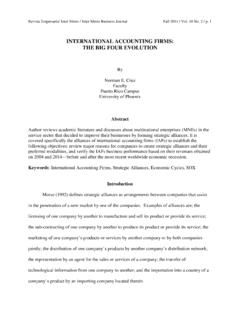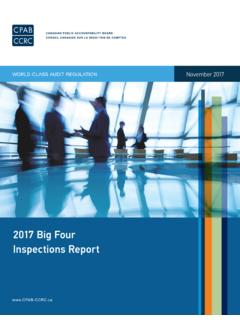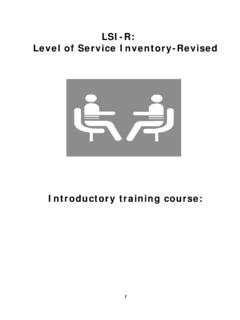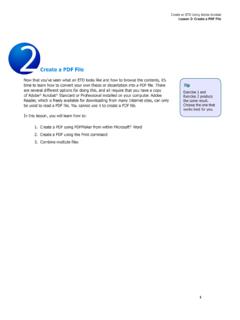Transcription of The Contributing Factors of Change in a Therapeutic Process
1 ORIGINAL PAPERThe Contributing Factors of Change in a TherapeuticProcessMichelle L. ThomasPublished online: 24 March 2006 Springer Science+Business Media, Inc. 2006 AbstractThe clients and therapists perceptions about the degree to which each of fourcommon Factors in therapy extra- Therapeutic Factors ; model/techniques; therapeuticalliance; and hope/expectancy contribute to Change in the Therapeutic Process wereinvestigated in this study. In addition, the perceptions about the percentage of changeattributed to clients and therapists were also explored. Results revealed that the therapistsand clients have different perceptions on what Factors contribute the most to Change andthat clients and therapists believe that the client contributes the most to Change in atherapeutic Factors in therapy Marriage and family therapy Change processClients spend less than 1% of their waking hours in therapy (Prochaska, 1999).
2 Along thesame lines, clients are likely to attend therapy one hour out of 168 hours within a weektime period. Given that therapy encompasses such a small amount of time, what is it aboutthe Therapeutic context that potentially leads to dramatic changes? Many researchers haveexplored the accountability of common Factors to the Process of Change in therapy(Frank, 1976; Garfield, 1992; Lambert, 1992; Hubble, Duncan, & Miller, 1999; Luborsky,Singer, & Luborsky, 1975; Rosenzweig, 1936; Sprenkle & Blow, 2004). Despite theresearch on common Factors in marriage and family therapy (MFT), the subject has yet todominate the thinking and practices of researchers, clinicians, and theoreticians in marriageand family therapy (Blow & Sprenkle, 2001).M. L. Thomas, MSW, is a doctoral student in Marriage and Family Therapy at Florida State L.
3 Thomas (&)Florida State University, 225 Sandels Bldg., Tallahassee 32306-1491, FL, USAE-mail: Fam Ther (2006) 28:201 210 DOI are Common Factors ?Saul Rosenzweig (1936) was the first to assert that there are common components amongdifferent therapies in his research on the effectiveness of treatment models (Sprenkle &Blow, 2004). His work coupled with that of other researchers has marked the developmentof the common Factors movement. As the progression developed so did controversy aboutthe common Factors approach in the field of MFT. Recently, there have been debates aboutthe existence and relevance of common Factors (Sexton, Ridley, & Kliener, 2004; Sprenkle& Blow, 2004). According to Sexton and associates (2004), common Factors depreciate theuniqueness of models or theories that have developed in the field of MFT.
4 In response,Sprenkle and Blow (2004) stated that the common Factors approach was not developed todiscredit the importance of the years of hard work that has been dedicated to creating anddeveloping various psychotherapy models. Nevertheless they desire marriage and familytherapists to recognize and use the existence of common Factors to establish more unity in afield that has been diversified by the large number of psychotherapy objective of the common Factors approach is to create a more practical and effectivetreatment based on these commonalities (Norcross, 1999). It is believed that with theimplementation of more research on common Factors there is the possibility for positiveclinical implications in MFT such as: economy and flexibility, weight to relative impor-tance of common Factors on the basis of the contribution to treatment outcomes, anddirection for future investigations into the relationship between common Factors andeffective therapy (Norcross, 1999).
5 According to Sprenkle and Blow (2004), common Factors are variables of the treatmentsetting that include the client, therapist, relationship, expectancy, and techniques that arenot specific to a particular model. These Factors establish the core ingredients and com-monalities that are shared by different therapies (Norcross, 1999). It is alleged that thesecommonalities are what bring about Change in therapy, not the specific techniques of theindividual models (Hubble et al., 1999). Norcross (1999) believes that these commonfactors contribute to the complex Therapeutic Process , and states that:Common Factors are not located solely in the therapist but also in the client not solely in the intra-therapyalliance, but also in the broader environmental context; not solely in formal treatment, but also as part ofclients self- Change (p.)
6 Xix).In this quote, Norcross presented his conclusion that common Factors are contributors tothe Therapeutic Process of Change . Lambert (1992), however, took it a step farther byassigning estimated percentages to each of the common big four Common FactorsThe big four (Hubble et al., 1999) label for common Factors was inspired by the work ofMichael Lambert (1992). Lambert suggested a four -factor model of Change based upon hisreview of empirical studies of outcome research (Norcross & Goldfried, 1992). The four -factor model includes: extra- Therapeutic Change Factors , common Factors , technique fac-tors, and expectancy Factors (Lambert, 1992). The model consists of estimated percentagesof variance in outcome that each factor contributes to Change in the Therapeutic , Duncan, and Hubble (1997) modified the four -factor model by placing all ofthe Factors under the rubric of common Factors and modifying the estimated modified four -factor model is composed of: client and extra- Therapeutic Factors ;202 Contemp Fam Ther (2006) 28:201 210123relationship Factors ; model or techniques, and expectancy Factors (Sprenkle & Blow, 2004)(Figure 1).
7 Client extra- Therapeutic Factors are estimated to contribute 40% to Change (Miller et al.,1997). Sprenkle and Blow (2004) reported that client Factors are the characteristics ofpersonality of the client. Extra- Therapeutic Factors are components in the life and envi-ronment of the client that affect the occurrence of Change , such as the client s innerstrengths, support system, environment, and chance events. More specific examples ofthese Factors include faith, persistence, supportive family members, community involve-ment, job, or a crisis situation (Hubble et al., 1999).Relationship Factors are estimated by Hubble and associates (1999) to account for 30%of the Change . This set of Factors represents the strength of the Therapeutic alliance betweenthe therapist and client(s).
8 This alliance is the joint product of the therapist and clienttogether focusing on the work of therapy (Sprenkle & Blow, 2004). Relationship factorsalso include behaviors provided by the therapist such as warmth, empathy, encouragement,and acceptance (Hubble et al., 1999).The last two components of the model, model/technique and hope/expectancy eachattributed 15% to the Change Process . The model/technique component consists of thetherapist s theoretical orientation, Therapeutic methods, strategies, or tactics implementedto move clients to take some action to improve themselves or their situation (Hubble et al.,1999). These Factors represent the unique parts to specific theories of therapy (Sprenkle &Blow, 2004). Lastly, hope or expectancy refers to the client becoming hopeful andbelieving in the credibility of the treatment (Sprenkle & Blow, 2004).
9 Lambert (1992) reported in his work that no statistical procedures were used to derivethe percentages in his model (p. 98). Although these percentages were estimates orassumptions developed from review of empirical studies, they have been frequently mis-interpreted and cited by researchers in literature as factual statements of the percentage ofvariance accounted for by the four Factors (Sprenkle & Blow, 2004). Even though theseeducated estimations are helpful, more research is needed to establish the accuracy of objective of this current study is to determine the clients and therapists percep-tions regarding the degree to which each of the common Factors contributes to Change inthe Therapeutic Process . Extra- Therapeutic Factors , model/techniques, Therapeutic relation-ship, and hope/expectancy, are the four Factors that guide this investigation.
10 In addition, theperceptions about the percentage attributed to clients and therapists are also explored. Theresearch questions are: (a) what are the percentages of Change attributed to each variableFig. 1 Estimated percentages ofthe common Factors (Miller et al.,1997)Client & Extra-therapeuticFactors40%RelationshipF actors30%Expectancy15%Model/ Techniques15%Contemp Fam Ther (2006) 28:201 210203123by the clients and therapists; (b) how are these Factors different from one another acrosscategories ( individual, couple, and family); and (c) what is the rank order of thevariables?MethodsThis study was conducted in a Commission on Accreditation for Marriage and FamilyTherapy Education (COAMFTE) accredited MFT doctoral program at a southeasternaccredited university. All of the doctoral students currently conducting therapy at the MFTtraining clinic and their present clients were invited to doctoral therapists conducting therapy consented to participate in the present of the therapists were female and three of the therapists were male.










